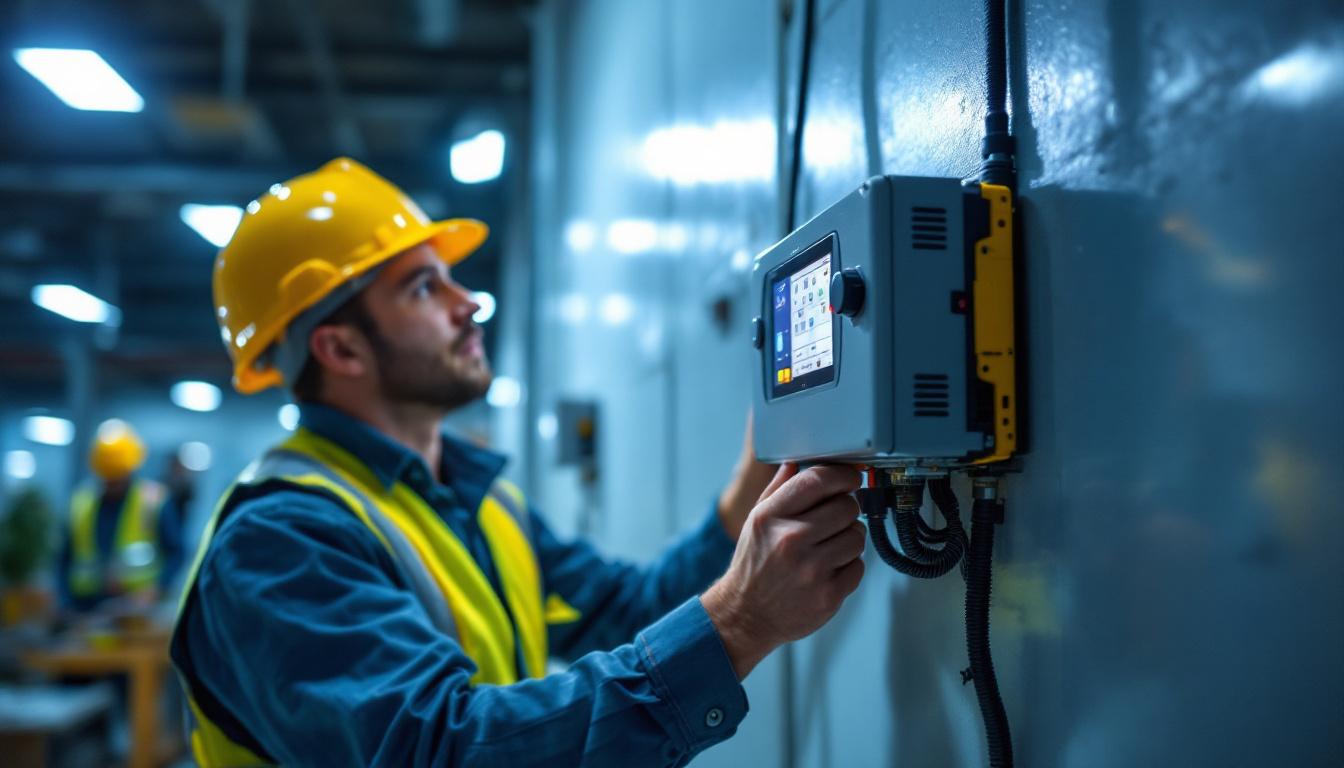
In the realm of electrical installations, emergency lighting inverters play a crucial role in ensuring safety and compliance. These devices are designed to provide backup power to emergency lighting systems during power outages, thereby illuminating escape routes and critical areas. For lighting contractors, understanding the fundamentals of emergency lighting inverters is essential for delivering effective solutions to clients.
Emergency lighting inverters convert stored battery energy into usable power for lighting fixtures. They are typically integrated with the building’s electrical system and can be activated automatically when the main power supply fails. This seamless transition is vital for maintaining safety in commercial and residential buildings alike. In addition to their primary function, these inverters can also enhance the overall energy efficiency of a building by ensuring that emergency lighting systems are only activated when necessary, thus conserving energy during normal operations.
Emergency lighting inverters consist of several key components that work together to ensure reliable operation. The inverter itself is the heart of the system, converting DC power from batteries into AC power for lighting. Additionally, battery storage systems are integral, providing the necessary energy reserve to power lights during outages. The choice of battery technology—whether lead-acid, lithium-ion, or nickel-cadmium—can significantly impact the performance and lifespan of the inverter system, making it essential for contractors to understand the pros and cons of each type.
Control circuits are also critical, as they manage the inverter’s operation, monitor battery health, and ensure that the system responds appropriately to power failures. These circuits often include features such as self-diagnostic capabilities, which can alert maintenance personnel to potential issues before they become critical. Understanding these components allows lighting contractors to troubleshoot issues and recommend suitable upgrades or replacements. Furthermore, familiarity with the latest advancements in inverter technology, such as smart monitoring systems and integration with building management systems, can provide contractors with a competitive edge in delivering state-of-the-art solutions that meet modern safety standards.
The landscape of emergency lighting inverters is evolving rapidly, driven by advancements in technology and changing regulatory requirements. Staying abreast of these trends is vital for lighting contractors aiming to provide cutting-edge solutions.
One of the most significant trends is the integration of smart technology into emergency lighting inverters. These systems can now be monitored and controlled remotely, allowing contractors to perform diagnostics and maintenance without needing to be physically present. This capability not only enhances efficiency but also improves response times in emergencies.
Smart inverters can send alerts regarding battery health, operational status, and potential failures, enabling proactive maintenance. This trend is particularly beneficial for large facilities where manual monitoring would be labor-intensive and time-consuming. Additionally, the use of IoT (Internet of Things) technology allows for seamless integration with building management systems, creating a holistic approach to facility management. This interconnectedness ensures that emergency lighting systems can be part of a larger safety protocol, enhancing overall building safety and operational efficiency.
As the push for sustainability continues to grow, energy efficiency has become a focal point in the design of emergency lighting inverters. Manufacturers are now developing systems that consume less power while providing the same level of illumination. This not only reduces operational costs but also aligns with environmental goals.
LED technology has played a significant role in this trend. By pairing emergency lighting inverters with LED fixtures, contractors can offer clients solutions that are both energy-efficient and cost-effective over the long term. This combination significantly extends battery life and reduces the frequency of replacements. Furthermore, the adoption of renewable energy sources, such as solar panels, is becoming increasingly popular in conjunction with emergency lighting systems. This not only enhances energy independence but also provides a reliable backup power source in case of grid failure, ensuring that safety measures remain intact during critical situations.
Regulations surrounding emergency lighting systems are continually evolving. Lighting contractors must stay informed about these changes to ensure compliance and avoid potential liabilities. Recent updates may include stricter requirements for testing, maintenance, and performance standards of emergency lighting inverters.
Understanding these regulations not only helps contractors provide compliant installations but also positions them as knowledgeable experts in the field. This can enhance their reputation and lead to increased business opportunities. Additionally, as building codes become more stringent, there is a growing emphasis on the importance of regular training and certification for contractors. This ensures that they are well-versed in the latest technologies and compliance standards, further solidifying their credibility in a competitive market. Moreover, engaging in continuing education programs can help contractors stay ahead of the curve, allowing them to offer innovative solutions that meet or exceed regulatory expectations.
Selecting the appropriate emergency lighting inverter for a project involves several considerations. Lighting contractors must assess the specific needs of the building, including its size, occupancy type, and local regulations. Each of these factors can significantly influence the choice of inverter.
Determining the power requirements is a critical first step. Contractors should calculate the total wattage needed for emergency lighting based on the number of fixtures and their power ratings. This assessment ensures that the inverter can handle the load during an outage, providing adequate illumination for safety.
Additionally, it’s essential to consider the duration of power backup required. Different facilities may have varying needs, from short-term solutions for small offices to extended backup for larger commercial spaces. Understanding these requirements helps in selecting an inverter with the appropriate battery capacity.
When choosing an emergency lighting inverter, evaluating its features and capabilities is crucial. Some inverters come equipped with advanced functionalities such as self-diagnostics, remote monitoring, and customizable settings. These features can enhance the overall performance and reliability of the emergency lighting system.
Contractors should also consider the inverter’s compatibility with existing lighting systems. Ensuring that the inverter can seamlessly integrate with the current electrical infrastructure can save time and reduce installation costs.
Proper installation of emergency lighting inverters is essential for their effective operation. Lighting contractors must adhere to best practices to ensure that these systems function reliably when needed most.
Each inverter model comes with specific installation guidelines provided by the manufacturer. Following these instructions is crucial for ensuring optimal performance and compliance with warranty requirements. Contractors should familiarize themselves with these guidelines before starting the installation process.
In addition to the manufacturer’s instructions, local codes and regulations must also be considered. Adhering to these standards not only ensures safety but also protects the contractor from potential legal issues.
Once the installation is complete, thorough testing and commissioning of the emergency lighting inverter are essential. This process involves verifying that the system operates correctly under various conditions, including power failure scenarios.
Contractors should perform regular maintenance checks and testing to ensure that the inverter is functioning as intended. This proactive approach can help identify potential issues before they become critical, ensuring that the emergency lighting system is always ready to perform.
During inspections, it’s also important to clean the inverter and its components. Dust and debris can accumulate over time, potentially affecting performance. Keeping the system clean helps maintain optimal functionality.
The batteries used in emergency lighting inverters have a finite lifespan and will eventually need replacement. Contractors should monitor battery health regularly and replace batteries as needed to ensure reliable operation. Many manufacturers provide guidelines on the expected lifespan of their batteries, which can help contractors plan for replacements.
Proper disposal of old batteries is also crucial, as they can contain hazardous materials. Contractors should follow local regulations regarding battery disposal to ensure environmental compliance.
The future of emergency lighting inverters looks promising, with ongoing advancements in technology and design. As the demand for reliable and efficient emergency lighting solutions continues to grow, manufacturers are likely to invest in research and development to enhance their products.
Emerging technologies such as energy storage systems and renewable energy integration are expected to shape the future of emergency lighting inverters. By harnessing solar energy or other renewable sources, these systems could provide more sustainable and efficient backup power solutions.
Additionally, advancements in battery technology, such as lithium-ion batteries, are likely to improve performance and reduce maintenance requirements. These innovations can lead to longer-lasting and more efficient emergency lighting systems.
As safety regulations become more stringent, the focus on compliance will only increase. Lighting contractors will need to stay informed about new standards and ensure that their installations meet or exceed these requirements. This emphasis on safety will drive the development of more reliable and effective emergency lighting solutions.
By embracing these trends and innovations, lighting contractors can position themselves as leaders in the industry, providing clients with cutting-edge solutions that enhance safety and compliance.
Emergency lighting inverters are an essential component of any emergency lighting system, ensuring safety and compliance in various settings. By understanding the latest trends, selecting the right products, and adhering to best practices in installation and maintenance, lighting contractors can deliver reliable solutions that meet the needs of their clients.
As technology continues to evolve, staying informed about advancements in emergency lighting inverters will be crucial for contractors aiming to remain competitive in the industry. Embracing innovation and prioritizing safety will not only enhance the contractor’s reputation but also contribute to the overall well-being of the communities they serve.
Ready to elevate your emergency lighting solutions with the latest trends and technologies? Look no further than LumenWholesale, where we provide lighting contractors with superior, spec-grade lighting products at unbeatable wholesale prices. Our commitment to quality, affordability, and convenience ensures that you have access to the best emergency lighting inverters and more, without the burden of inflated markups. Take advantage of our hassle-free bulk buying and free shipping to get your premium lighting efficiently and at the best value. Don’t compromise on performance or cost—Wholesale Lighting at the Best Value is just a click away. Experience the LumenWholesale difference today!

Discover how over bar lighting can transform your space with its versatile and stylish design.

Explore how industrial LED light fixtures are revolutionizing modern lighting solutions with their energy efficiency, durability, and sleek design.

Discover the frequent pitfalls lighting contractors face when installing outdoor solar flood lights.

Discover essential tips and strategies to prevent costly errors in your lighting projects with LED work lights.